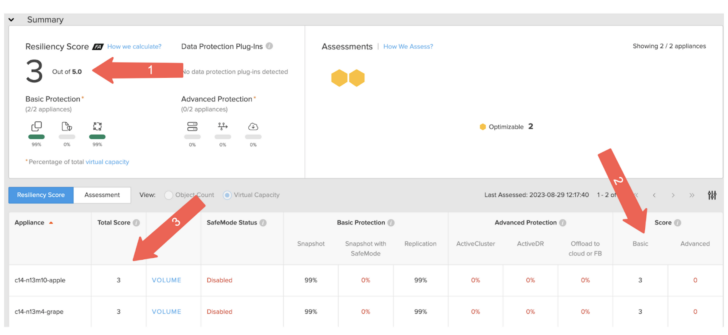Video gaming used to be an entirely different experience back in the day. I’m not just talking about the 8- or 16-bit graphics. Once upon a time, scoring the latest game title meant an excursion to the local mall with fistfuls of cash earned from a paper route or fixing the neighbor’s computer. Publishers like Sierra, Virgin, and LucasArts were at the top of my wish lists with game worlds that left us enchanted, and at times, frustrated by their devilish puzzles. At that point, you had no choice but to return to the mall to pick up an old-school gamer’s guide or magazine to get unstuck.
resWhen it comes to architecting data resilience solutions, the journey can feel a lot like an old-school video game. Just swap out pirates and villains for hackers and accidental data wipes. If you’ve got Pure Storage, then your inventory is loaded with power-ups like snapshots, SafeMode™, ActiveCluster™, ActiveDR™, and CloudSnap™. These aren’t just shiny trinkets; they’re the arsenal you’ll use to protect your kingdom of data from natural disasters, malicious invaders, and those self-inflicted errors. It’s up to you and other players, such as your account team and partners, to configure your loadout. On top of all that, there’s another option already in your arsenal: Pure1® is your ultimate gamer’s guide to mastering data resilience.
For the newbies, Pure1 is our SaaS-based storage management platform. There are no microtransactions here as Pure1 is freely available to all Pure Storage customers. It includes a data protection assessment that benchmarks your storage configuration against Pure’s own leading practices built on years of experience and working with our customers. This will help you to identify any gaps in your data resilience and guide you through the appropriate remediation steps. You can read more about it in our blog or check out our saucy Digital Bytes episode.
Part of the Data Protection Assessment is the new Data Resiliency Score. While the Data Protection Assessment is all about the configuration of your storage, the Data Resiliency Score is more of an indicator of what level you’re on. The more you leverage your FlashArray™ system’s data protection features, the higher your score.
See it in action! Check out the Data Resiliency Score on Digital Bytes.
How the Data Resiliency Score Is Calculated

The Data Resiliency Score ranges from 0 to 5 and each data protection feature is assigned a weighted score broken down by basic and advanced features. For basic features, snapshots get one point, while snapshots with SafeMode and replication get two points. Leveraging advanced FlashArray features, such as ActiveCluster, ActiveDR, or offloading to the cloud or FlashBlade®, will give you one additional point. Points are granted based on the percentage of your overall virtual capacity that’s protected by each feature.
For example, suppose you have an array with 100TiB of virtual capacity. If just 50% of that data is protected by snapshots, then you’ll have a basic resiliency score of .5 (1 point x 50%) . If you were to protect those snapshots with SafeMode, then your score would double because snapshots with SafeMode are worth two points. If you were to replicate that data with ActiveDR, then you would get two more points for replication and an additional point for leveraging an advanced data protection feature for a total score of 2.5 (basic score of 2 plus .5 advanced points). To achieve a perfect score of 5, you would need to apply these to 100% of the data.
While having a perfect score is a great achievement and will provide you with a significant constitution buff, it may not be achievable for everyone. The Data Resiliency Score only takes the FlashArray features mentioned earlier into account, so a low score doesn’t necessarily mean you’re at high risk. For example, if you’re using third-party solutions to protect your data, then chances are you’re fine with a lower score. In fact, Pure1 will call out when we detect third-party plugins such as Veeam and Commvault. The use of these solutions won’t impact your Data Resiliency Score, but the callouts provide additional context to help explain why your score might be lower than expected.
So what is a good score then? Based on the examples above, you can see we weren’t fully protected from things like malicious attacks until we implemented SafeMode, which took us over one point. As a general guideline, between one and two points indicates that you know what you’re doing. You understand the basic data protection features provided by FlashArray and have worked to implement them. A score of two to three points means you’re well on your way and have likely discovered your FlashArray system’s advanced data protection features. A score of three to four points means you’re a hero of your data protection realm, while a score of five points makes you a champion. Of course, the best thing to do is to work with your partners and Pure account teams to identify what the right target score is for your organization based on your goals, your FlashArray systems, and third-party solutions.

Pure1 will show you the average Resiliency Score across your entire fleet (arrow 1 above) as well as a breakdown of your basic and advanced scores (arrow 2) and a combined total (arrow 3) for each array. Applying filters will update the total resiliency score (arrow 1) to show the average for just those arrays. Plus scores can be exported for project planning or to track your progress over time.
The Data Resiliency Score along with the Data Protection Assessment are vital to unlocking new achievements in protecting your critical data. And because the quest for epic data protection is an ongoing adventure, Pure1 is available for you to use at any time whether you’re on a quest to establish data dominance or want to make sure you still hold the high score. Log in to Pure1 today. Your adventure awaits!
![]()






